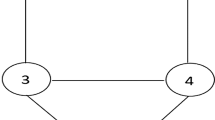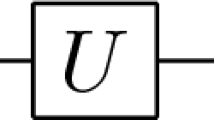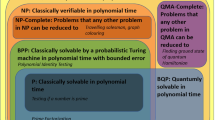Abstract
Quantum Bridge Analytics relates generally to methods and systems for hybrid classical-quantum computing, and more particularly is devoted to developing tools for bridging classical and quantum computing to gain the benefits of their alliance in the present and enable enhanced practical application of quantum computing in the future. This is the first of a two-part tutorial that surveys key elements of Quantum Bridge Analytics and its applications, with an emphasis on supplementing models with numerical illustrations. In Part 1 (the present paper) we focus on the Quadratic Unconstrained Binary Optimization model which is presently the most widely applied optimization model in the quantum computing area, and which unifies a rich variety of combinatorial optimization problems. This document extends an original version published in 4OR to include a section on advanced models related to quantum optimization and a section reporting comparative computational results on challenging combinatorial applications.
Similar content being viewed by others
Notes
This adds a constant to (1), which is irrelevant for optimization.
Reference to quantum computing would not be complete without mentioning Google’s recent claim to achieving ‘quantum supremacy.’ This outcome has no bearing on the computational considerations discussed here. See, for example, Preskill (2019).
References
Ailon, N., Charikar,M. A., Newman (2008) “Aggregating inconsistent information: ranking and clustering. Journal of the ACM (JACM), 55(5), 2
Aimone,J. B., Hamilton, K. E., Mniszewsk, S., Reeder, L., Schuman, C. D., Severa,W. M. (2018). Non-neural network applications for spiking neuromorphic hardware. In PMES Workshop.
Albash, T., Lidar D. A. (2015) Decoherence in adiabatic quantum computation. Physical Review A vol. 91, p. 062320. arXiv:1503.08767v2.
Albash, T., Hen, I., Spedalieri, F. M., Lidar, D. A. (2015). Reexamination of the evidence for entanglement in the D-Wave processor. Physical Review A vol. 92, pp. 62328. arXiv:1506.03539v2
Alidaee, B., Glover, F., Kochenberger, G., & Rego, C. (2005). A new modeling and solution approach for the number partitioning problem. Journal of Applied Mathematics and Decision Sciences, 9(2), 135–145.
Alidaee, B., Kochenberger, G., Lewis, K., Lewis, M., & Wang, H. (2008). A new approach for modeling and solving set packing problems. European Journal of Operational Research, 186(2), 504–512.
Aloise, D., Cafieri, S., Caporossi, G., Hansen, P., Perron, S., & Liberti, L. (2010). Column generation algorithms for exact modularity maximization in networks. Physical Review E, 82(4), 046112.
Alom, M. Z., Van Essen, B., Moody, A. T., Widemann, D. P., Taha, T. M. (2017). Quadratic unconstrained binary optimization (QUBO) on neuromorphic computing system. In IEEE 2017 International joint conference on neural networks (IJCNN). Doi https://doi.org/10.1109/ijcnn.2017.7966350.
AlphaQUBO. (2021). http://meta-analytics.net/Home/AlphaQUBO
Amin, M. H. S., Truncik, C. J. S., Averin, D. V. (2008). Role of single qubit decoherence time in adiabatic quantum computation. Physical Review A, vol. 80, p. 022303. arXiv:0803.1196v2
Anthony, M., Boros, E., Crama, Y., & Gruber, A. (2017). Quadratic reformulations of nonlinear binary optimization problems. Mathematical Programming, 162(1–2), 115–144.
Aramon, M., Rosenberger, G., Valiante, E., Tamura, H., Miyazawa, T., & Katzgraber, H. G. (2019). Physics-inspired optimization for quadratic unconstrained problems using a digital annealer. Frontiers in Physics, 7, 48.
Bauckhage, C., Piatkowski, N., Sifa, R., Hecker, D and Wrobel, S. (2019). A QUBO formulation of the k-medoids problem. LWDA.
Berwald, J. J., Gottlieb, J. M., Munch, E. (2018). Computing wasserstein distance for persistence diagrams on a quantum computer. arXiv:1809.06433
Boixo, S., Rønnow, T. F., Isakov, S. V., Wang, Z., Wecker, D., Lidar, D. A., Martinis, J. M., & Troyer, M. (2014). Evidence for quantum annealing with more than one hundred qubits. Nature Physics, 10, 218–224.
Boros, E., & Hammer, P. (1991). The max-cut problem and quadratic 0–1 optimization: polyhedral aspects, relaxations and bounds. Annals of Operations Research, 33(3), 151–180.
Boros, E., & Hammer, P. (2002). Pseudo-Boolean optimization. Discrete Applied Mathematics, 123(1), 155–225.
Boros, E., Hammer, P. L., Sun, R., & Tavares, G. (2008). A max-flow approach to improved lower bounds for quadratic unconstrained binary optimization (QUBO). Discrete Optimization, 5(2), 501–529.
Chapuis, G., Djidjev, H., Hahn, G., Rizk, G. (2018). Finding maximum cliques on the D-Wave quantum annealer,” To be published in: Journal of Signal Processing Systems, DOI https://doi.org/10.1007/s11265-018-1357-8.
Clark J., West, T., Zammit, J., Guo, X., Mason, L., Russell, D .(2019). Towards real time multi-robot routing using quantum computing technologies In HPC Asia 2019 proceedings of the international conference on high performance computing in Asia-Pacific Region, pp. 111–119.
Cohen, J., Khan, A., and Alexander, C. (2020). Portfolio optimization of 60 stocks using classical and quantum algorithms. arXiv:2008.08669
Date, P., Patton, R., Schuman, C., & Potok, T. (2019). Efficiently embedding QUBO problems on adiabatic quantum computers. Quantum Information Processing, 2019(18), 117. https://doi.org/10.1007/s11128-019-2236-3
Debenedictis, E. P. (2019). A future with quantum machine learning. IEEE Computing Edge, 5(3), 24–27.
Du, Y., Glover, F., Hennig, R., Kochenberger, G and Wang, H. (2020a) .Optimal solutions to the set partitioning problem: a comparison of alternative models Working paper, University of Colorado Denver.
Du, Y., Kochenberger, G., Glover, F., Wang, H., Lewis, M., Tsuyuguchi, T., & Hulandageri, A. (2020b). Solving clique partitioning problems: A comparison of models and commercial solvers. International Journal of Information Technology & Decision Making, 21(01), 59–81.
Dunning, L., Gupta, S., & Silberholz, J. (2018). What works best when? A systematic evaluation of heuristics for Max-Cut and QUBO. INFORMS Journal on Computing, 30(3), 608–624.
Elsokkary, N., Khan, F.S., Humble, T. S., Torre, D. L., & Gottlieb, J. (2017). Financial portfolio management using D-Wave’s quantum optimizer: the case of Abu Dhabi securities exchange. 2017 IEEE High-performance Extreme Computing (HPEC).
Yarkoni, S., Plaat, A., & Back, T. (2018). First results solving arbitrarily structured maximum independent set problems asing Q]quantum annealing. In 2018 IEEE Congress on evolutionary computation (CEC), Rio de Janeiro, pp. 1–6. Doi: https://doi.org/10.1109/CEC.2018.8477865.
Farhi, E., Goldstone, J. (2014). A quantum approximate optimization algorithm. arXiv:1411.4028
Feld, S., Roch, C., Gabor, T., Seidel, C., Neukart, F., Galter, I., Mauerer, W., Linnhoff-Popien, C. (2018). A hybrid solution method for the capacitated vehicle routing problem using a quantum annealer. arXiv:1811.07403
Forrester, R. J., & Hunt-Isaak, N. (2020). Computational comparison of exact solution methods for 0–1 quadratic programs: recommendations for practitioners. Journal of Applied Mathematics, 2020, 21.
Glover, F. (1997). A template for scatter search and path relinking. In J.-K. Hao, E. Lutton, E. Ronald, M. Schoenauer & D. Snyers (Eds.), Artificial evolution, lecture notes in computer science (pp. 13–54). Springer.
Glover, F., Kochenberger, G., Alidaee, B., Amini, M. (2002b) . Solving quadratic Knapsack problems by reformulation and Tabu search. In P.M. Pardalos, A. Megados, R. Burkard (Eds.) Combinatorial and global optimization, World Scientific Publishing Co., pp. 272–287
Glover, F., Kochenberger, G., Wang, Y. (2018a). A new QUBO model for unsupervised machine learning. Research in Progress.
Glover, F., Kochenberger, G. (2019). Quantum bridge analytics & QUBO 2.0. In Quantum insight conference 2019, invited presentation 10/04/19, LHOFT—Luxembourg house of financial technology, 9, rue du Laboratoire, Luxembourg.
Glover, F. (1977). Heuristics for Integer programming using surrogate constraints. Decision Sciences, 8(1), 156–166.
Glover, F. (1996). Tabu search and adaptive memory programming - advances, applications and challenges. In R. S. Barr, R. V. Helgason, & J. L. Kennington (Eds.), interfaces in computer science and operations research. Kluwer Academic Publishers Springer.
Glover, F., Alidaee, B., Rego, C., & Kochenberger, G. (2002a). One-pass heuristics for large scale unconstrained binary quadratic problems. European Journal of Operational Research, 137(2), 272–287.
Glover, F., Kochenberger, G., & Alidaee, B. (1998a). adaptive memory tabu search for binary quadratic programs. Management Science, 44(3), 336–345.
Glover, F., Kochenberger, G., & Du, Y. (2019). Quantum bridge analytics I: A tutorial on formulating and using QUBO models. 4OR Quarterly Journal of Operations Research Invited Survey, 17, 335–371.
Glover, F., & Laguna, M. (1997). Tabu search. Kluwer Academic Publishers.
Glover, F., Lewis, M., & Kochenberger, G. (2018b). Logical and inequality implications for reducing the size and difficulty of unconstrained binary optimization problems. European Journal of Operational Research, 265(2018), 829–842.
Glover, F., Mulvey, J., Bai, D., & Tapia, M. (1998b). Integrative Population analysis for better solutions to large-scale mathematical programs. In G. Yu (Ed.), Industrial applications of combinatorial optimization (pp. 212–237). Kluwer Academic Publishers.
Grant, E., Humble, T. (2020). Benchmarking quantum annealing controls with portfolio optimization. arXiv:2007.03005v1.
Hahn, G., Djidjev, H. (2017). Reducing binary quadratic forms for more scalable quantum annealing. 2017 IEEE international conference on rebooting computing. DOI: https://doi.org/10.1109/ICRC.2017.8123654.
Hamilton, K., Schuman, C.D., Young, S. R., Imam, N., Humble, T. S. (2018). Neural networks and graph alogrithms with next-generation processors. In 2018 IEEE International parallel and distributed processing symposium workshops (IPDPSW). DOI: https://doi.org/10.1109/IPDPSW.2018.00184
Hong, S. W., Miasnikof, P., Kwon, R., & Lawryshyn, Y. (2021). Market graph clustering via QUBO and digital annealing. Risk and Financial Management, 14, 34.
Hoos, H. H. (2012). Programming by optimization. Communications of the ACM, 55(2), 70–80.
Kalra, A,. Qureshi, F., Tisi, M. (2018). Portfolio asset identification using graph algorithms on a quantum annealer. http://www.henryyuen.net/fall2018/projects/qfinance.pdf
Kerberos (2019) Kerberos: the network authentication protocol, https://web.mit.edu/kerberos/.
Kochenberger, G., Glover, F. (2006). A unified framework for modeling and solving combinatorial optimization problems: A tutorial. In: W. Hager, S-J Huang, P. Pardalos, O. Prokopyev (Eds.), Multiscale optimization methods and applications (pp. 101–124). Springer.
Kochenberger, G., Glover, F., Alidaee, B., & Lewis, K. (2005c). Using the unconstrained quadratic program to model and solve max 2-sat problems. International Journal of OR, 1(1), 89–100.
Kochenberger, G., Glover, F., Alidaee, B., & Rego, C. (2005a). An unconstrained quadratic binary programming approach to the vertex coloring problem. Annals of OR, 139(1–4), 229–241.
Kochenberger, G., Glover, F., Alidaee, B., & Wang, H. (2005b). Clustering of micro array data via clique partitioning. Journal of Combinatorial Optimization, 10(1), 77–92.
Kochenberger, G., Hao, J.-K., Glover, F., Lewis, M., Lu, Z., Wang, H., & Wang, Y. (2014). The Unconstrained binary quadratic programming problem: A survey. Journal of Combinatorial Optimization, 28(1), 58–81.
Kochenberger, G., Hao, J.-K., Lu, S., Wang, H., & Glover, F. (2013). Solving large scale max cut problems via Tabu search. Journal of Heuristics, 19(4), 565–571.
Kochenberger, G., & Ma, M. (2019). Quantum computing applications of QUBO models to portfolio optimization. Denver: University of Colorado.
Kochenberger, G., Du, Y. Glover, F., Wang, H., Lewis, M., Tsuyuguchi, T., & Hulandageri, A. (2021). Solving clique partitioning problems: A comparison of models and commercial solvers, working paper.
Kowalsky, M., Albash, T., Hen, I., & Lidar, D. (2021). Benchmarking state of the art ising machines. APS March Meeting 2021. Bulletin of the American Physical Society, 66(1).
Lanting, A. J., Przybysz, AYu., Smirnov, F. M., Spedalieri, M. H., Amin, A. J., Berkley, R., Harris, F., Altomare, S., Boixo, P., Bunyk, N., Dickson, C., Enderud, J. P., Hilton, E., Hoskinson, M. W., Johnson, E., Ladizinsky, N., Ladizinsky, R., Neufeld, T., Oh, I., Wilson, G. R. (2014). Entanglement in a quantum annealing processor. Physical Review. https://doi.org/10.1103/PhysRevX.4.021041
Lewis, M., Verma, A. (2021). Working Paper, Missouri Western University.
Lewis, M., Kochenberger, G., & Alidaee, B. (2008). A new modeling and solution approach for the set partitioning problem. Computers and OR, 35(3), 807–813.
Liu, X., Laporte, G., Chen, Y., & He, R. (2017). An adaptive large neighborhood search metaheuristic for agile satellite scheduling with time-dependent transition time. Computers and Operations Research, 86, 41–53.
Lucas, A. (2014). Ising formulations of many NP problems. Frontiers in Physics, 5, 2.
Meta-Analytics. (2020). QUBO based portfolio model. Working paper. http://meta-analytics.net/index.php/resources/.
Mniszewski, S., Negre, C., & Ushijima-Mwesigwa, H. (2017). Graph partitioning using the D-wave for electronic. In Proceedings of the Second International Workshop on Post Moores Era Supercomputing (pp. 22–29). November 2017. https://doi.org/10.1145/3149526.3149531.
Mniszewski, S. M., Negre, C. F. A., & Ushijima-Mwesigwa, H. (2018). Graph clustering approaches using near term quantum computing. In QUBITS 2018 D-Wave Users Conference. September 2018. https://www.dwavesys.com/media/wafcrbie/18_wed_am_graph_lanl.pdf.
Mugel, S., Kuchkovsky, C., Sanchez, E., Fernandez-Lorenzo, S., Luis-Hita, J., Lizaso, E., Orus, R. (2020). Dynamic Portfolio optimization with real datasets using quantum processors and quantum-inspired tensor networks. arXiv:2007.00017v1.
Multiverse. (2020a). Credit card fraud, (A Company White paper) https://www.multiversecomputing.com/
Multiverse (2020b), Credit Scoring, (A Company White paper) https://www.multiversecomputing.com/
Negre, C. F. A., Ushijima-Mwesigwa, H., Mniszewsk, S. M. (2019). Detecting multiple communities using quantum annealing on the D-Wave system. arXiv:1901.09756
Neukart, F., Compostella, G., Seidel, C., Dollen, D., Yarkoni, S., Parney, B. (2017). Traffic flow optimization using a quantum annealer. arXiv:1708.01625
O’Malley, D., Vesselinov, V. V., Alexandrov, B. S., & Alexandrov, L. B. (2018). Nonnegative/binary matrix factorization with a D-Wave quantum annealer. PLoS ONE, 13(12), e0206653. https://doi.org/10.1371/journal.pone.0206653
Ohzeki, M., Miki, A., Miyama, M.J., Terabe, M. (2018). Control of automated guided vehicles without collision by quantum annealer and digital devices. arXiv:1812.01532
Oliveira, N. M. D., Silva, R. M. D. A., & Oliveira, W. R. D. (2018). QUBO formulation for the contact map overlap problem. International Journal of Quantum Information, 16(8), 1840007.
Oshiyama, H., Ohzeki, M. (2021). Benchmark of quantum-inspired heuristic solvers for quadratic unconstrained binary optimization. arXiv preprint arXiv:2104.14096.
Pakin, S. (2017). Navigating a maze using a quantum annealer. In Proceedings of the second international workshop on post moores era supercomputing, Pp. 30–36.
Pakin, S. (2018) QMASM—quantum macro assembler. https://ccsweb.lanl.gov/~pakin/software/ and https://github.com/lanl/qmasm
Palmer, S., Sahin, S., Hernandez, R., Mugel, S., Orus, R. (2021). Quantum portfolio optimization with investments bands and target volatility. arXiv:2106.06735v3
Pardalos, P., & Xue, J. (1999). The maximum clique problem. Journal of Global Optimization, 4(3), 301–328.
Pelofske, E., Hahn, G., Djidjev., H. (2019) Solving large maximum clique problems on a quantum annealer. arXiv:1901.07657
Phillipson, F., Bhatia, H.S. (2020). Portfolio optimization using the D-Wave quantum annealer. arXiv:2012.01121v1
Preskill, J. (2019). Why I called it ‘quantum supremacy’. Quanta Magazine. https://www.quantamagazine.org/john-preskill-explains-quantum-supremacy-20191002/
Pudenz, K. L., & Lidar, D. A. (2013). Quantum adiabatic machine learning. Quantum Information Processing, 12(5), 2027–2070.
Qbit 1 (2017) Optimal feature selection in credit scoring and classification using a quantum annealer (A Company White paper), http://1qbit.com/files/white-papers/1QBit-White-Paper-%E2%80%93-Optimal-Feature-Selection-in-Credit-Scoring-and-Classification-Using-a-Quantum-Annealer_-_2017.04.13.pdf
Qbsolv (2017). D-Wave initiates open quantum software environment. www.dwavesys.com/press-releases/d-wave-initiates-open-quantum-software-environment.
QC Ware Corporation. (2018). A quadratic unconstrainted binary optimization problem formulation for single-period index tracking with cardinality constraints. http://web.stanford.edu/~rsarkar/materials/index-tracking-white-paper.pdf.
Reedy, C. (2017). When will quantum computers be consumer products?” Futurism, https://futurism.com/when-will-quantum-computers-be-consumer-products
Reinhardt, S. (2018). Detecting lateral movement with a compute-intense graph Kernel. http://www.clsac.org/uploads/5/0/6/3/50633811/reinhardt-clsac-2018.pdf
Rodriguez-Heck, E. (2018). Linear ad quadratic reformulations of nonlinear optimization problems in binary variables. PhD Dissertation, Liege University
Rosenberg, I. (1975). Reduction of bivalent maximization to the quadratic case. Cahiers du Centre d’Etudes de Recherche Operationnelle, 17, 71–74.
Sahner, D. (2018). A potential role for quantum annealing in the enhancement of patient outcomes? https://www.dwavesys.com/sites/default/files/Sahner.2018.pdf
Samorani, M., Wang, Y., Wang, Z., Lu, Y., & Glover, F. (2019). Clustering-driven evolutionary algorithms: An application of path relinking to the quadratic unconstrained binary optimization problem. Special Issue on Learning, Intensification and Diversification. Journal of Heuristics, 25, 629–642.
Schneidman, E., Berry, M. J., Segev, R., & Bialek, W. (2006). Weak pairwise correlations imply strongly correlated network states in a neural population. Nature, 440(7087), 1007–1012.
Schuetz, M. J. A., Brubaker, J. K., Katzgraber, H. G. (2021). Combinatorial optimization with physics-inspired graph neural networks. arXiv preprint arXiv:2107.01188.
Shaydulin, R., Ushijima-Mwesigwa, H., Safro, I., Mniszewski, S., Alexeev, Y. (2018). Community detection across emerging quantum architectures. PMES workshop.
Tomasiewicz, D., Pawlik, M., Malawski., M., Rycerz, K. (2020). Foundations for workflow application scheduling on D-Wave System. In Computational science—ICCS 2020: 20th International conference, Amsterdam, The Netherlands, June 3–5, 2020, Proceedings, Part VI, 12142, 516–530. Doi: https://doi.org/10.1007/978-3-030-50433-5_40
Ushijima-Mwesigwa, H., Negre, C. F. A., Mniszewsk, S. M. (2017). Graph partitioning using quantum annealing on the D-Wave System. arXiv:1705.03082.
Venturelli, D., Kondratyev, A. (2018). Reverse quantum annealing approach to portfolio optimization problems. arXiv:1810.08584v2.
Vyskocil, T., Djidjev, H. N. (2019). Constraint embedding for solving optimization problems on quantum annealers. In 2019 IEEE international parallel and distributed processing somposium workshops, P. 635–644.
Vyskocil, T., Pakin, S., & Djidjev, H. N. (2019). Embedding inequality constraints for quantum annealling optimization. In S. Feld & C. Linnhoff-Popien (Eds.), Quantum technology and optimization problems QTOP 2019. Lecture notes in computer science. Springer.
Wang, H., Wang, Y., Resende, M., Kochenberger, G. (2016). A QUBO approach to solving QAP problems. Unpublished manuscript.
Wang, Q., Abdullah, T. (2018). An introduction to quantum optimization approximation algorithm. https://www.cs.umd.edu/class/fall2018/cmsc657/projects/group_16.pdf
Wang, H., Alidaee, B., Glover, F., & Kochenberger, G. (2006). Solving group technology problems via clique partitioning. International Journal of Flexible Manufacturing Systems, 18(2), 77–87.
Wang, Y., Lu, Z., Glover, F., & Hao, J.-K. (2012). Path relinking for unconstrained binary quadratic programming. European Journal of Operational Research, 223(3), 595–604.
Wang, Y., Lu, Z., Glover, F., & Hao, J.-K. (2013). Backbone guided tabu search for solving the UBQP problem. Journal of Heuristics, 19(4), 679–695.
Xie, P., Wang, H., Chen, Y., & Wang, P. (2019). A Heuristic algorithm based on temporal conflict network for agile earth observing satellite scheduling problem. IEEE Access Digital Object Identifier. https://doi.org/10.1109/ACCESS.2019.2902669
Yu, H., Huang, Y., & Wu, B. (2018). Exact equivalence between quantum adiabatic algorithm and quantum circuit algorithm. Chinese Physics Letters. https://doi.org/10.1088/0256-307X/35/11/110303
Zhou, L., Wang, S., Choi, S., Pichler, H., Lukin, M. D. (2018). Quantum approximate optimization algorithm: performance, mechanism, and implementation on near-term devices. arXiv:1812.01041
Acknowledgements
This tutorial was influenced by our collaborations on many papers over recent years with several colleagues to whom we owe a major debt of gratitude. These co-workers, listed in alphabetical order, are: Bahram Alidaee, Dick Barr, Andy Badgett, Rajesh Chawla, Jin-Kao Hao, Mark Lewis, Karen Lewis, Zhipeng Lu, Abraham Punnen, Cesar Rego, Yang Wang, Haibo Wang and Qinghua Wu. Other collaborators whose work has inspired us are too numerous to mention. Their names may be found listed as our coauthors on our home pages.
Author information
Authors and Affiliations
Corresponding author
Additional information
Publisher's Note
Springer Nature remains neutral with regard to jurisdictional claims in published maps and institutional affiliations.
This is an updated version of the paper that appeared in 4OR, 17 (4), 335–371 (2019).
Rights and permissions
About this article
Cite this article
Glover, F., Kochenberger, G., Hennig, R. et al. Quantum bridge analytics I: a tutorial on formulating and using QUBO models. Ann Oper Res 314, 141–183 (2022). https://doi.org/10.1007/s10479-022-04634-2
Accepted:
Published:
Issue Date:
DOI: https://doi.org/10.1007/s10479-022-04634-2




